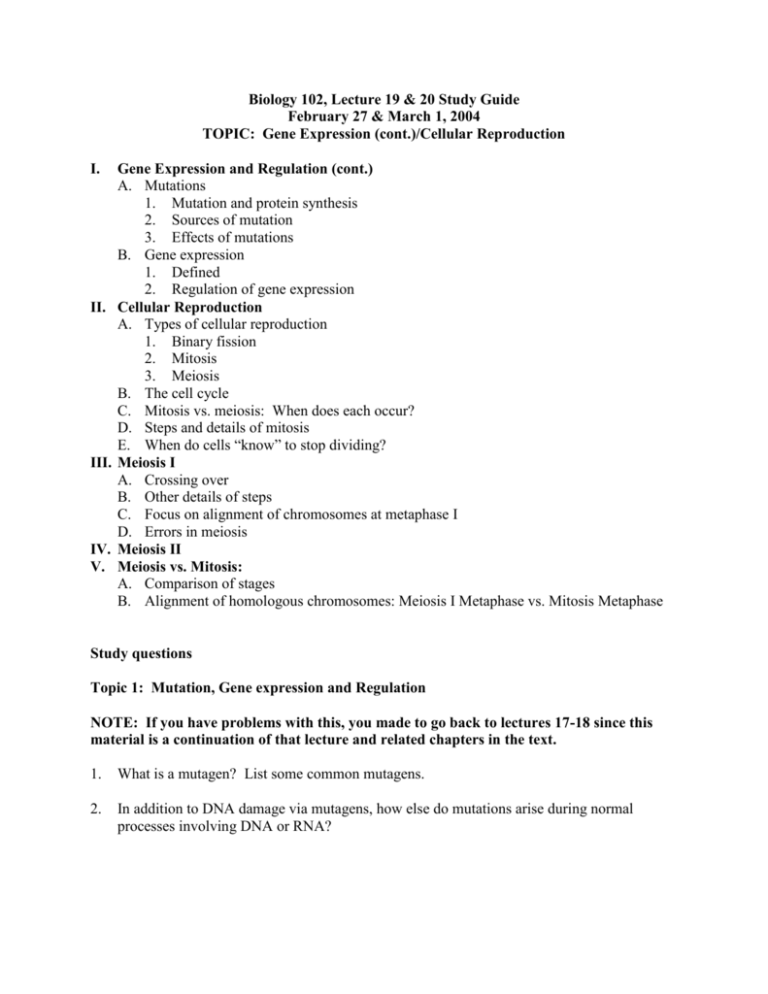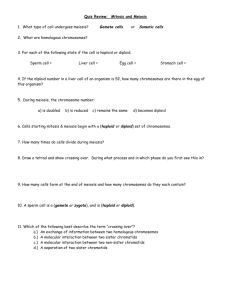Biology 102, Lectures 19
advertisement

Biology 102, Lecture 19 & 20 Study Guide February 27 & March 1, 2004 TOPIC: Gene Expression (cont.)/Cellular Reproduction I. II. III. IV. V. Gene Expression and Regulation (cont.) A. Mutations 1. Mutation and protein synthesis 2. Sources of mutation 3. Effects of mutations B. Gene expression 1. Defined 2. Regulation of gene expression Cellular Reproduction A. Types of cellular reproduction 1. Binary fission 2. Mitosis 3. Meiosis B. The cell cycle C. Mitosis vs. meiosis: When does each occur? D. Steps and details of mitosis E. When do cells “know” to stop dividing? Meiosis I A. Crossing over B. Other details of steps C. Focus on alignment of chromosomes at metaphase I D. Errors in meiosis Meiosis II Meiosis vs. Mitosis: A. Comparison of stages B. Alignment of homologous chromosomes: Meiosis I Metaphase vs. Mitosis Metaphase Study questions Topic 1: Mutation, Gene expression and Regulation NOTE: If you have problems with this, you made to go back to lectures 17-18 since this material is a continuation of that lecture and related chapters in the text. 1. What is a mutagen? List some common mutagens. 2. In addition to DNA damage via mutagens, how else do mutations arise during normal processes involving DNA or RNA? 3. What makes some mutations neutral? Provide an example of a “neutral” mutation from the perspective of the nucleic acid sequence, resulting amino acid sequence and the protein structure itself. 4. What makes some mutations harmful (i.e. they have deleterious effects)? Give an example of a harmful mutation and compare that to #3 above. 5. How might it be possible for a mutation to actually be beneficial? 6. Name one key way that genetic variation arises in populations. [HINT: Question 5...] 7. What is “gene expression”? Do all cells express all genes? 8. List several ways/places along the pathway of “information flow” within the cell that gene expression is regulated. a. NOTE: You can explain this in a logical way as you go step-by-step through transcription, translation, etc... (See Fig. 10-8 and related portions of text). Topic 2: Cellular reproduction 1. What type of organisms reproduce asexually by binary fission? 2. How do “sister chromatids” differ from “homologous chromosomes”? (Understanding this is very important!) 3. Why did I say that the concept of “twin sister chromatids” would be useful when thinking about mitosis? 4. What is the difference between a diploid and a haploid cell? Use the words “homologous chromosomes” in your answer! 5. Mitosis or meiosis? a. After this process, the resulting “daughter” cells are exactly like the parent cell in terms of chromosome make-up. b. The parent cell is diploid, but daughter cells are haploid. c. After this process, one parent cell has divided into four daughter cells. d. Tissue differentiation in animals and plants results from this process. e. The production of gametes results from this process. f. The initial cell divisions of an embryo occur by this process g. Growth of an animal or plant occurs by this process. HINT: Three are “meiosis” and four are “mitosis”. 6. Sketch the cell cycle, being sure to indicate where in the cycle: a. DNA replication occurs b. Growth occurs c. Mitosis occurs d. Cytokinesis occurs 7. What is chromatin? 8. What is the role of microtubules in the process of mitosis or meiosis? What type of macromolecule makes up the microtubules? What structures give rise to the spindle microtubules? 9. What structure connects the sister chromatids to each other? 10. Sketch the different stages of mitosis, being sure to show the following: a. Number of homologous pairs of chromosomes i. For simplicity, your sketches should include two pairs of homologous chromosomes. Each pair should be a characteristic length, as shown in your text. b. Whether chromosomes exist as paired sister chromatids vs. as single chromatids c. Location of chromosomes within cell at the different stages d. For metaphase, how the homologous chromosomes are aligned with each other (end to end or side-by-side?), and how the sister chromatids of an individual chromosomes are oriented with respect the midline of the cell . What are homologous chromosomes? What are sister chromatids? Be sure you understand the difference. 11. 12. Diploid or haploid? a. What’s the difference between a diploid cell and a haploid cell? b. If you have a homologous pair of chromosomes that exist as paired sister chromatids, is that cell diploid or haploid? c. If you have a homologous pair of chromosomes that exist as single chromatids, is that cell diploid or haploid? d. If you have a single chromosome (no homologous one within the cell) that exists as paired sister chromatids, is that cell diploid or haploid? e. If you have a single chromosome (no homologous one within the cell) that exists as a single chromatid, is that cell diploid or haploid? ANSWERS (a rare thing...): b and c are DIPLOID, d and e are HAPLOID. As long as you have a homologous pair, the cell is DIPLOID! Otherwise, the cell is haploid even if the chromosome has duplicated so there are sister chromatids! Got it? Good! 13. What keeps cells from dividing forever? 14. What “cues” do cells use to tell when to stop dividing? 15. How do cancer cells differ from normal cells? 16. What are the key advantages of asexual reproduction? What are the key disadvantages? 17. What are the key advantages of sexual reproduction? What are the key disadvantages? 20. In the process of crossing over: a. Does the process occur between sister chromatids of the same chromosome? b. Does the process occur between chromosomes of two homologous chromosomes? c. What is the end result of crossing over? State in both words and a sketch. d. During what stage(s) does crossing over occur? 21. In metaphase of meiosis I a. How do homologous chromosomes align with each other? Compare this with metaphase of meiosis II and mitosis. 22. During anaphase of meiosis I, is it sister chromatids OR homologous chromosomes that are pulled to opposite ends of the cell? Compare this with anaphase of meiosis 2 and mitosis. 23. Diploid or haploid? a. The cell before meiosis b. The 2 cells that have formed after Meiosis I Think carefully: Is there a pair of homologous chromosomes present, or just a single (though duplicated) chromosome? c. The four cells that are the end result of both divisions. ANSWERS: a=diploid, b and c are haploid! Note that during Meiosis I, the homologous chromosomes split up! So even though there are sister chromatids attached, there is no homologous pair.







